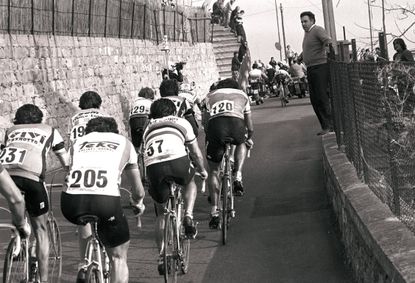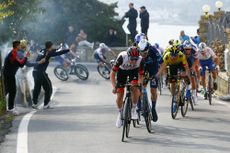Icons of cycling: Il Poggio di San Remo
Chris Sidwells admires Milan-San Remo's great leveller
- (opens in new tab)
- (opens in new tab)
- (opens in new tab)
- Sign up to our newsletter Newsletter


It’s the jewel in the crown of Milan-San Remo, a 3.7km climb that snakes its way up the Via Duca d’Aosta then helter-skelters back down to the streets of San Remo. The famous last climb of the first Monument of the cycling season, the Poggio always sets up a spectacular finish.
>>> Milan-San Remo: how the last 16 editions have been won
The Poggio was first included in 1960, when a climb starting eight kilometres from the finish was included to break up the big groups that were increasingly deciding Milan-San Remo. It worked, René Privat of France launched a solo attack on the Poggio to win. Raymond Poulidor won alone the following year, as did Emile Daems of Belgium in 1962.
Then in 1964 Poulidor and Tom Simpson dropped the remains of a break on the climb, with Simpson eventually winning on the Via Roma.
And so the story continued. Eddy Merckx made the Poggio his own, with seven Milan-San Remo victories between 1966 and 1976, nearly always pulling something special on the climb. Michele Dancelli won solo in 1970. And in 1974 Felice Gimondi supplied one of the great moments of the Poggio when he climbed it alone wearing the rainbow jersey and riding a Bianchi bike.
Then bigger group finishes started happening again. More climbs were added; La Cipressa in 1982 and La Manie in 2010, beefing up a course that already had the 532-metre Turchino Pass, and the three Capi; the Mele, Cervo and Berta that carry an ancient road, the Via Julia Augusta, along the Mediterranean coast. But those hills just tire the legs, acting as lenses focusing the action on the Poggio.
It starts as a right-hand turn off the Strada Statale 1. The gradient changes, but not by much until the first right bend.
With an average of 3.7 per cent, the Poggio is never really steep, but it’s enough to make a difference if the will and form is there.
The steepest gradient, eight per cent, comes before a green-painted house on the inside of a left-hand bend. Then the last quarter of the Poggio begins. Sprinters start hoping they will be there, climbers attack because they can.
More lefts and rights, past the cylindrical irrigation pools, then the gradient lessens. The summit comes quickly, scruffy farms replaced by smart houses. The last gambit is an attack across the top then a reckless descent. It’s worked in the past, most famously for Sean Kelly in 1992.
More than any other climb, the descent of the Poggio is as important as the ascent. No one can relax: lose concentration and the wheel in front and all the hard work on the climb can be thrown away.

Thank you for reading 10 articles this month* Join now for unlimited access
Enjoy your first month for just £1 / $1 / €1
*Read 5 free articles per month without a subscription

Join now for unlimited access
Try first month for just £1 / $1 / €1

Chris has written thousands of articles for magazines, newspapers and websites throughout the world. He’s written 25 books about all aspects of cycling in multiple editions and translations into at least 25
different languages. He’s currently building his own publishing business with Cycling Legends Books, Cycling Legends Events, cyclinglegends.co.uk, and the Cycling Legends Podcast
-
-
 Outdoor clothing brand Jack Wolfskin doubles down on bikepacking apparel and luggage
Outdoor clothing brand Jack Wolfskin doubles down on bikepacking apparel and luggageThe outdoor brand rolls into the adventure cycling market with a more refined collection
By Hannah Bussey • Published
-
 High-end bikes still in demand says Giant, as it announces 12.5% revenue increase
High-end bikes still in demand says Giant, as it announces 12.5% revenue increaseBut like much of the industry the Taiwanese manufacturer is also experiencing a surplus of low to mid priced stock
By James Shrubsall • Published
-
 Matej Mohorič considering using a dropper seatpost for Strade Bianche
Matej Mohorič considering using a dropper seatpost for Strade BiancheThe Bahrain Victorious star won Milan-San Remo in 2022 with the help of a dropper post
By Tom Thewlis • Last updated
-
 No win for Jonas Vingegaard? Cycling Weekly's bold predictions for the 2023 season
No win for Jonas Vingegaard? Cycling Weekly's bold predictions for the 2023 seasonWith under a fortnight until the WorldTour kicks off this year, it is time to take a look into our crystal ball
By Adam Becket • Published
-
 From the World Championships to Paris-Roubaix: Cycling Weekly's wins of 2022
From the World Championships to Paris-Roubaix: Cycling Weekly's wins of 2022It is hard to look past Annemiek van Vleuten, but we tried, so here is the best win of the year, plus nine more
By Adam Becket • Published
-
 'Once in a lifetime': Matej Mohorič on his stunning Milan-San Remo victory in 2022
'Once in a lifetime': Matej Mohorič on his stunning Milan-San Remo victory in 2022The dropper post, the daredevil descending, and the Monument win
By Tom Thewlis • Published
-
 Milan-San Remo's organiser is planning to create women's event for 2023
Milan-San Remo's organiser is planning to create women's event for 2023RCS is looking to add a women's Milan-San Remo to the calendar next year
By Ryan Dabbs • Published
-
 Wout van Aert: 'I wasted a lot of energy on Pogačar’s attacks'
Wout van Aert: 'I wasted a lot of energy on Pogačar’s attacks'Belgian says lack of cohesion in the chasing group cost them a shot at Milan-San Remo victory
By Richard Windsor • Published
-
 Tadej Pogačar: 'I didn’t dare follow Mohorič at Milan-San Remo, I know that he's crazy when the road goes down'
Tadej Pogačar: 'I didn’t dare follow Mohorič at Milan-San Remo, I know that he's crazy when the road goes down'The Tour de France champion came up short after repeated attacks on the Poggio
By Richard Windsor • Published
-
 Five talking points from Milan-San Remo 2022
Five talking points from Milan-San Remo 2022The spring Classics season got off with a bang at the first Monument of the year
By Stephen Puddicombe • Published









